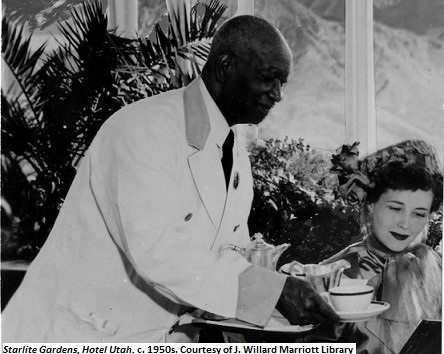Dublin Core
Title
Description
The old Hotel Utah has a storied history of hospitality that is shadowed by the racial prejudice common throughout Utah right into the 1960s.
Located on South Temple and Main Street in downtown Salt Lake City, the venerated Hotel Utah was known in its day as “the Great White Palace.” It hosted Heads of State, United States presidents, and Hollywood greats.
Yet when the internationally celebrated opera singer Marian Anderson made a concert stop in Utah in 1937, she couldn’t find a hotel room. Anderson was African-American. When she returned a year later, the Hotel Utah relented, as long as she used the freight elevator and didn’t eat in the public dining room. Anderson's experience was one of many Utah examples of racial discrimination that also included other noted entertainers. Paul Robeson, Harry Belafonte, Ella Fitzgerald, and Lionel Hampton were all directed to the back elevator and ate meals in their rooms.
In 1954, Frontier magazine compared discrimination in Utah, Nevada, and Arizona with the American South. This was despite a 1948 Utah law making it a misdemeanor to refuse service to Black people. During this time, Utah realtors attempted – but failed – to create segregated neighborhoods in Salt Lake and Ogden. In 1955, Marion Mills, an African-American military veteran, wrote to the Salt Lake Tribune complaining that Black people were “required to occupy balcony seats in many local theaters“ and that certain jobs in Salt Lake were unavailable to Black people, as were most night clubs and bars. Mills could have also mentioned that hospitals restricted Black patients to private rooms and kept separate the plasma of Black people and white people in their blood banks. Utah passed even stricter laws against interracial marriages during the 1950s. When these laws were repealed in 1963, the state barely beat out Wyoming, the last Western state to abandon its interracial marriage laws.
The African-American population in the Beehive State has grown markedly since then, and the days of “the Great White Palace” are gone — in more ways than one. But is Utah truly free from discrimination?
Creator
Source
Image: Starlite Gardens, Hotel Utah. c. 1950s. "The Great White Palace" restricted African-American guests from staying in the hotel and eating in the common dining room. That did not prevent the hotel from using African-Americans as a labor force in their dining rooms and kitchens, serving all-white clientele. Courtesy of J. Willard Marriott Library.
_______________
See Thomas Alexander, Utah the Right Place: The Official Centennial History, rev. edition (Salt Lake City, Gibbs Smith Publisher, 1996), p. 389; Box Elder News Journal, “Hotel Utah,” July 7, 1911, p. 2; F. Ross Peterson, “’Blindside’: Utah on the Eve of Brown v. Board of Education,” Utah Historical Quarterly Vol. 73, Number 1, Winter 2005), pp. 5, 9, 11; Mills, Marion L., letter to the editor quoted in F. Ross Peterson, “Blindside: Utah on the Eve of Brown v. Board of Education,” p. 10; Mason, Patrick Q. “The Prohibition of Interracial Marriage in Utah, 1888-1963,” Utah Historical Quarterly, Volume 76, Number 2, Spring 2008, p. 129; Heidi Swinton, “Hotel Utah,” Utah History Encyclopedia, http://www.media.utah.edu/UHE/, accessed June 8, 2011.

